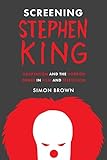Screening Stephen King : Adaptation and the Horror Genre in Film and Television / Simon Brown.
Material type: TextPublisher: Austin : University of Texas Press, [2021]Copyright date: ©2018Description: 1 online resource (226 p.)Content type:
TextPublisher: Austin : University of Texas Press, [2021]Copyright date: ©2018Description: 1 online resource (226 p.)Content type: - 9781477314937
- American fiction -- Film adaptations -- 20th century
- American fiction -- 20th century -- Film adaptations
- American fiction
- Horror films -- History and criticism -- United States
- Horror films -- United States -- History and criticism
- Horror films
- Horror television programs -- History and criticism -- United States
- Horror television programs -- United States -- History and criticism
- Horror television programs
- Motion pictures -- History and criticism -- United States
- Motion pictures -- United States
- Motion pictures -- United States -- History and criticism
- PERFORMING ARTS / General
- 813/.54 23
- PS3561.I483 Z6223 2018
- online - DeGruyter
| Item type | Current library | Call number | URL | Status | Notes | Barcode | |
|---|---|---|---|---|---|---|---|
 eBook
eBook
|
Biblioteca "Angelicum" Pont. Univ. S.Tommaso d'Aquino Nuvola online | online - DeGruyter (Browse shelf(Opens below)) | Online access | Not for loan (Accesso limitato) | Accesso per gli utenti autorizzati / Access for authorized users | (dgr)9781477314937 |
Frontmatter -- Contents -- Acknowledgments -- Introduction -- Chapter 1. Mainstream Horror and Brand Stephen King -- Chapter 2 . Stephen King from Vietnam to Reagan: The Early Adaptations and the Establishment of Brand Stephen King on the Screen -- Chapter 3. The Mainstream Adaptations, 1986–2007 86 -- Chapter 4 . Stephen King as Low-Budget and Straight-to-DVD Horror -- Chapter 5. Stephen King as TV Horror -- Conclusion. The Future Is Also History: The Contemporary Evolution of Brand Stephen King -- Selected TV and Filmography -- References -- Index
restricted access online access with authorization star
http://purl.org/coar/access_right/c_16ec
Since the 1970s, the name Stephen King has been synonymous with horror. His vast number of books has spawned a similar number of feature films and TV shows, and together they offer a rich opportunity to consider how one writer’s work has been adapted over a long period within a single genre and across a variety of media—and what that can tell us about King, about adaptation, and about film and TV horror. Starting from the premise that King has transcended ideas of authorship to become his own literary, cinematic, and televisual brand, Screening Stephen King explores the impact and legacy of over forty years of King film and television adaptations. Simon Brown first examines the reasons for King’s literary success and then, starting with Brian De Palma’s Carrie, explores how King’s themes and style have been adapted for the big and small screens. He looks at mainstream multiplex horror adaptations from Cujo to Cell, low-budget DVD horror films such as The Mangler and Children of the Corn franchises, non-horror films, including Stand by Me and The Shawshank Redemption, and TV works from Salem’s Lot to Under the Dome. Through this discussion, Brown identifies what a Stephen King film or series is or has been, how these works have influenced film and TV horror, and what these influences reveal about the shifting preoccupations and industrial contexts of the post-1960s horror genre in film and TV.
Mode of access: Internet via World Wide Web.
In English.
Description based on online resource; title from PDF title page (publisher's Web site, viewed 26. Apr 2022)


